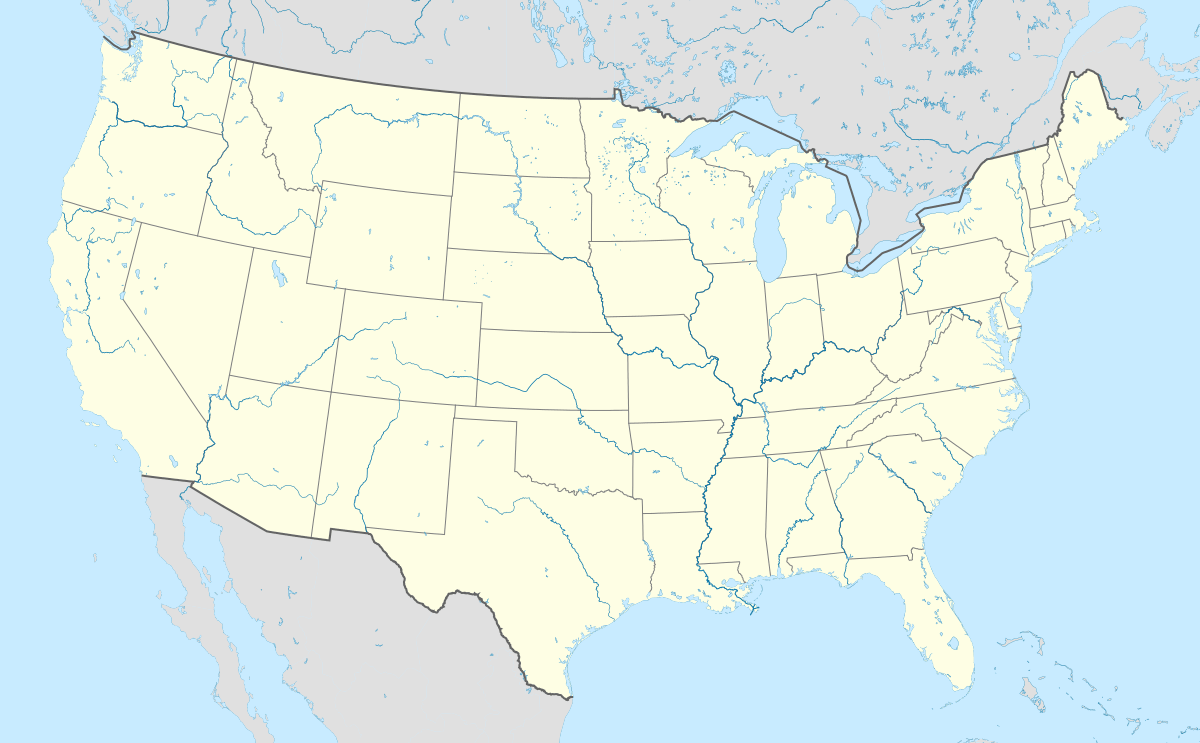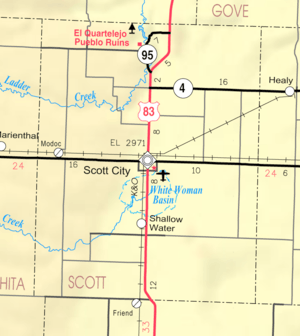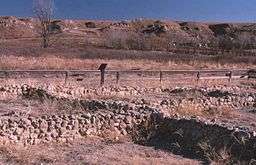El Quartelejo Ruins
|
El Cuartelejo | |
|
Ruins of El Quartelejo | |
  | |
| Nearest city | Scott City, Kansas |
|---|---|
| Coordinates | 38°40′41″N 100°54′51″W / 38.67806°N 100.91417°WCoordinates: 38°40′41″N 100°54′51″W / 38.67806°N 100.91417°W |
| Built | 1650 |
| NRHP Reference # | 66000351 |
| Significant dates | |
| Added to NRHP | October 15, 1966[1] |
| Designated NHLD | July 19, 1964[2] |

El Quartelejo, or El Cuartelejo (from Spanish cuartelejo, meaning far quarter or district) is the name given to the archeological remains of the northernmost Indian pueblo and the only known pueblo in Kansas. Located in Lake Scott State Park, the remains of the stone and adobe pueblo are situated north of Scott City, Kansas, on Ladder Creek.
There are two possibilities for the origin of El Quartelejo. In 1664 a group of Pueblo Indians left New Mexico and were later rounded up and brought back by the Spanish. They may have constructed El Quartelejo, but more likely is the second possibility. After the collapse of the Pueblo Revolt (1680–1692) most Pueblo Indians accepted the return of Spanish dominion over their lives. A group from the Taos and Picuris Pueblos, however, did not. In 1696 this group fled New Mexico in search of a new home among the Plains Apache. They moved to the Great Plains and evaded the Spanish for ten years. During the years that followed came reports of Frenchmen attempting to trade with the Cuartelejo Apaches. The ill-fated Villazur expedition stopped at El Cuartelejo on its way north to investigate the extent of French influence. Near the forks of the Platte River, the Pawnees killed most of the party, reportedly under French direction. In 1706 they were captured and forced back to New Mexico. When the Pueblo Indians were seized, the Spanish commander, Juan de Ulibarrí, wrote that they were dwelling in houses of a permanent type. The Spanish called this settlement El Quartelejo and the region around it was called San Luis Province.
No Indians lived in El Quartelejo after 1706, but Spanish and French occasionally occupied the structure as a frontier outpost during the 18th century. By the 1730s raids by Comanche, Ute, and Pawnee had decimated the Cuartelejo Apache. The survivors moved south to join the Jicarilla Apache at Pecos. However, after 1763 and the French retreat from the area, the pueblo was abandoned with only a mound and a few irrigation ditches remaining. Eventually, its walls decayed and the structure was buried by drifting soil.
The pueblo was unknown to American explorers, but in 1898 archeologists rediscovered El Quartelejo. Since then, the site has been excavated to reveal that the pueblo was a seven-room structure, enough to house a small band of Indians. Near the pueblo are traces of shallow ditches extending from the nearby springs. These ditches were most likely used to irrigate crops in nearby fields.
Near here in 1878, Col. William H. Lewis, commanding troops from Fort Dodge, was fatally wounded in a battle with chief Dull Knife and his Northern Cheyennes. Lewis was the last army officer killed by Indians in Kansas.
In 1964, the El Quartelejo ruins were designated a National Historic Landmark,[2] and the area is now part of Lake Scott State Park. The Scott Lake site was developed in 1971 as an interpretive exhibit by Kansas Historical Society archeologists. The outline of the ruins was restored and markers placed for park visitors to see. Since 2004, the National Park Service has listed the El Quartelejo site as "at risk" because of ongoing weather-related deterioration to the ruins.
El Quartelejo Museum in Scott City, Kansas is operated by the Scott County Historical Society. The free museum focuses on local interests, from prehistory to the present day. Temporary exhibits highlight contemporary arts or culture.
The Spanish spelling of El Quartelejo is with a “C”: El Cuartelejo. The English spelling is with a “Q”: El Quartelejo. They are both correct and are used interchangeablely at the museum and the park.
References
- ↑ National Park Service (2007-01-23). "National Register Information System". National Register of Historic Places. National Park Service.
- 1 2 "El Quartelejo". National Historic Landmark summary listing. National Park Service. Retrieved 2008-04-03.
External links
- El Quartelejo Museum - Local museum named after the ruins
- El Cuartelejo – “The Home Far Away”
- Text of highway historical marker
